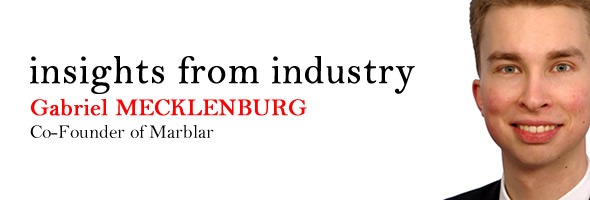
Please can you explain what Marblar is and how Marblar works?
Marblar is gamifying the process of technology transfer. We post technology on our platform in the form of a challenge, and the Marblar community then competes to uncover new problems these technologies could solve – thereby discovering new market applications for these technologies.
We reward the Marblar community with online points and cash prizes. We’ve found that above all, our community really values the interaction with other scientists from different backgrounds, inventors, and putting their own unique skillsets to use to advance technology.
Since launching in late October 2012, we’ve had thousands of scientists, engineers and business professionals from around the world sign up, and we’ve featured technology from Oxford, CalTech and London among others.
The team are all medical science PhDs ourselves – and as such the prospect of helping technology make a greater real-world impact is really close to our hearts.
What was the first unused invention posted on Marblar that was found a medical application?
In fact, every technology we’ve featured thus far has found medical applications; it’s been really incredible. That’s partly a result of our user-base having a strong representation from people with a health and life science background.
In our initial proof-of-concept, we conducted a challenge around a new method for stringing DNA strands together without using an enzyme: very much niche organic chemistry technology. The winning idea was an application that took this technique and applied it to solving a big problem in high-throughput screening of oligonucleotide therapeutics, and gauging their on-rate/off-rate.
Please can you tell us about the spectrophotometer that was originally developed for use in space? What medical application was found for this device?
This is a really neat example of the power of Marblar’s open approach. The Science and Technology Facilities Council, which runs a research institute south of Oxford, sought to develop a device that, during a future space mission, could reliably and accurately analyze the atmosphere on Mars. It had to be small, robust, and extremely sensitive – and that’s just what they developed. Only, NASA beat the Europeans to Mars – so they figured, hey, why not find some terrestrial applications! So they came to us.
Over the course of the competition we got ideas from all over the spectrum – ranging from the oil industry to food quality control. The winning idea, however, came from a life science PhD student who astutely realized that in liver disease the body produces more ammonia, which can actually be measured in the patient’s breath. Given the features of the device (small, portable, extremely accurate), instead of attaching it to a Mars Rover, why not place it in a nurse’s hand? Current liver function tests require invasive blood draws, and don’t instantly give you a result. This would be non-invasive, extremely cheap, and would deliver immediate results. And due to its flexibility it could also be used to diagnose a range of other diseases that change the chemical composition of exhaled breath, such as diabetes.
Please can you tell us about the range of medical applications that were found for the SlipChip device from Caltech?
Professor Rustem Ismagilov of Caltech and his former student, Dr Feng Shen, developed an incredibly simple, versatile, and inexpensive lab-on-a-chip device capable of performing many reactions in parallel and in series – all with two bits of plastic and a whole lot of ingenuity.
It can be used for a whole range of biochemical assays (such as digital PCR) and they got some very specific and detailed ideas for the best clinical applications. These ranged from rapid tissue-typing for on-the-spot matching of donor organs, to screening for circulating tumor DNA, and even directed evolution of phage as an alternative to increasingly ineffective antibiotics.
Do you think all these clinical applications would have been found for the SlipChip if Marblar didn’t exist?
To quote one of the inventors, Professor Ismagilov: “We were remarkably impressed with the depth and vibrancy of the intellectual engagement of the community. As such it was very difficult to select just one winner.“
Marblar allowed the inventors to very rapidly tap the creativity and specialised knowledge of a really diverse set of people. This kind of broad perspective is something that is just not available any other way. Fundamentally, even a brilliant engineer can learn lot from a moderately good biologist.
Rustem and Feng are obviously brilliant – they would have certainly come up with a few of the proposed applications. But not all of them, not without a great deal of effort, not with as much breadth and technical depth, and certainly not this quickly. What is also neat is that inventors are able to interact directly with the crowd during the competition, so Feng was actually able to direct the evolution of some of the ideas. It was a lot of fun to watch.
What medical applications have so far been proposed for the nanospray device originally developed for positioning satellites?
This was our second gadget from the Science and Technology Facilities council designed for use in space and now in search of some terrestrial applications. The device creates an incredible fine jet of particles, which can be used to position satellites in space. However, they realized it could also be re-purposed to accurately and evenly deposit nanometre-thin films of a wide range of materials onto all sorts of substrates.
They came to us to discover what interesting substrate/coating systems they should focus their efforts on, and they actually found a huge number of medical applications. These ranged from coating orthopaedic and dental implants with minerals for better integration, to coating cerebral implants with bioactive peptides for reduced inflammation and even using it to introduce stem cells into a variety of settings for regenerative medicine. The latter would be especially interesting – one of the killer features of the technique is its mild nature, which means that live cells can survive being sprayed onto surfaces and into crevices.
In addition to providing a space for people to post their ideas for unused inventions, does Marblar help original inventors to act upon the winning idea, i.e. will these proposed medical applications come to fruition?
We provide the inventors with a plan-of-action and a list of relevant industry contacts for the most promising applications found by Marblar. Our goal is for the technology holders to have an incredible amount of due-diligence and brainstorming done, and for them to have a precise idea of which industry contacts to approach to help them move their science to the next step. We have quite a few plans for how we can expand our post-competition service, but we want to initially focus our efforts and manpower on the area where we can have the biggest impact – which is in providing that bright spark of creativity from which a technology can be developed into a host of new directions.
What impact do you think Marblar will have on medicine?
We think that the incredible pool of underused technology out there could have a profound impact on patients’ health. There just needs to be more opportunities to think creatively around these otherwise dormant technologies so that we can uncover the medical problems they could solve. And from the looks of it, we’re off to a great start!
Would you like to make any further comments?
We’d love for you to check out some of the amazing science we have posted on the site right now. If you’re a reader of News Medical we’d love to give your technology priority listing onto Marblar – to find new applications, revenue streams and paths to market.
Where can readers find more information?
You can find us at Marblar.com and can get in touch via [email protected] or twitter (@play_marblar).
About Gabriel Mecklenburg
 Gabriel Mecklenburg is the co-founder and COO of Marblar.com – a fast growing platform that seeks to crowdsource novel market applications for dormant and emerging technologies. After completing a degree in Materials Science at the University of Cambridge, he is now a PhD student at Imperial College London working in the field of Regenerative medicine.
Gabriel Mecklenburg is the co-founder and COO of Marblar.com – a fast growing platform that seeks to crowdsource novel market applications for dormant and emerging technologies. After completing a degree in Materials Science at the University of Cambridge, he is now a PhD student at Imperial College London working in the field of Regenerative medicine.